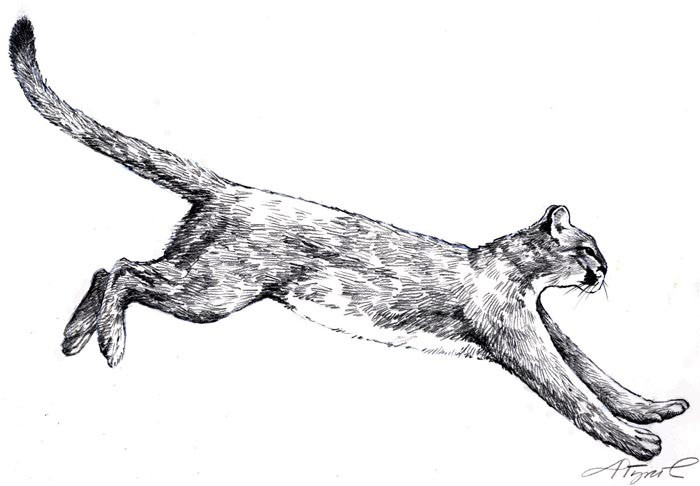
Leslie Bowen and her husband, Myron, keep track of 350 cattle, 28 horses, 30 pigs, and 120 chickens on their farm North Hollow Farm in Rochester, Vermont. For almost a year, Bowen has also been on the trail of what she says is a mountain lion.
She’s seen mountain lions before, Bowen says, in northern Arizona, where she lived for two years before moving to Vermont. Bowen says she has no doubt about what she saw on North View Drive one morning last March.
“It stood between knee- and hip-high, was tawny colored, had a big head, and that very long, thick, graceful tail,” she says. “It sort of looked at me for a few seconds, and then, very casually, slipped into the woods.”
Since then, Bowen and at least six neighbors say they’ve seen a mountain lion. Coming out of a barn full of horses. Passing through drivers’ headlights. Watching a child play basketball.
Felis concolor – an unspotted cat known variously as cougar, puma, mountain lion, panther, and, here in New England, catamount, from cat-of-the-mountains – once roamed North America from coast to coast. By the turn of the century, however, extensive logging and relentless hunting of what had become accepted as a dangerous pest had taken a toll on F. concolor cougar, the eastern subspecies of mountain lion. While the lion continued to survive on bigger lands out West, the cats seemingly disappeared from northern New England.
Catamounts are not particularly fussy about where they live. They require 5 to 25 square miles to roam but reportedly live quite contentedly on the outskirts of Californian and Coloradan suburbs. Despite news of mauled joggers and babies in these states, we’re more likely to die from a bee sting than in the jaws of a catamount, who prefer deer and sometimes beaver or wild turkey, none of which is in short supply here in the Green Mountain State. According to the U.S. Fish & Wildlife Service, mountain lions will occasionally eat domestic livestock, “when available.” Nobody argues that Vermont wouldn’t make a perfectly suitable hangout for catamounts. And why not Rochester?
Vermont’s Fish & Wildlife Department has recorded an average of 38 sightings a year for the last 10 years. Here’s the rub. In the hundred-plus years that have passed since 1881, when Alexander Crowell shot and killed a mountain lion in Barnard (starting in January, its stuffed carcass will be on display at the Vermont Historic Society’s museum in Montpelier), only one sighting has been proven with hard evidence.
And that was almost 10 years ago, in 1994 , after a man named Mark Walker spotted a mother catamount and two cubs in Craftsbury. Scat bagged soon after was sent off to the U.S. Fish & Wildlife Service’s forensic lab in Oregon, which a few months later confirmed that the sample contained the hair of a mountain lion.
What couldn’t be determined, and what remains the center of considerable debate, is where Vermont’s mystery cats might be coming from. Catamounts are solitary, shy, and elusive; their very survival is based on an ability to remain unseen and unheard while stalking prey. No small feat for an animal that, as a yearling, might well weigh 90 pounds.
They could be part of a remnant population that, by sticking through the tough times, is thriving in regenerated forests bursting with white-tailed deer. They could be coming down from the remote reaches of Canada or northern Maine. Or, as some speculate about the coyote in the 1950s, perhaps they’re making a generations-long migration from out West.
Then again, Vermont’s cats may not be wild at all but commercially bred animals escaped from their cages or released by tired owners or even wildlife activists looking to accelerate a cougar reintroduction. Doug Blodgett, the Vermont Fish & Wildlife Department biologist who followed up on Leslie Bowen’s call, repeatedly emphasizes how cheaply and easily you or I could buy a catamount over the Internet. “Two thousand bucks and you, too, could own a cougar,” he says.
Back in Rochester, the Bowens watch over their cattle, which, Bowen reports, have taken to circling instinctively around their young at even the slightest disruption. The tracks she cast and the scat sample she bagged at the request of the Vermont Fish & Wildlife Department both have been tested and identified as “canine.” But Bowen says she knows it’s a catamount out there. Says Blodgett, “We just don’t have the resources to follow up on all these sightings.”
When asked about the catamount’s ghost-like visitations, Susan Morse, a forestry and wildlife consultant and founder of Huntington-based Keeping Track, says, “The only answer to the question of whether catamounts are here in Vermont is that no one knows for sure.”

